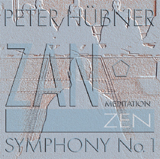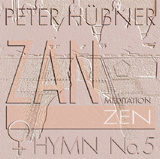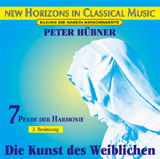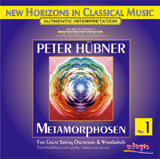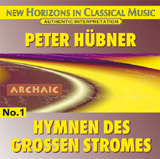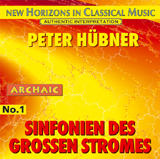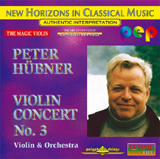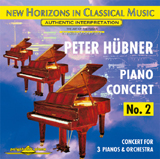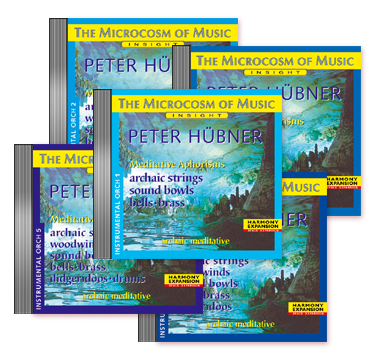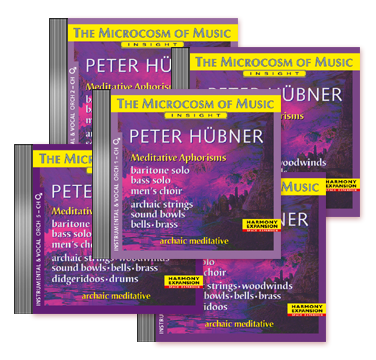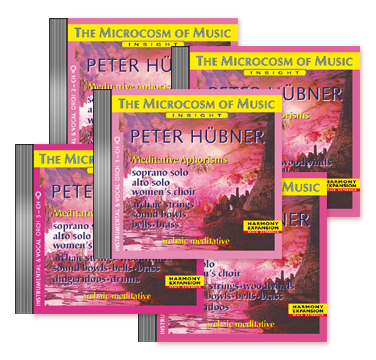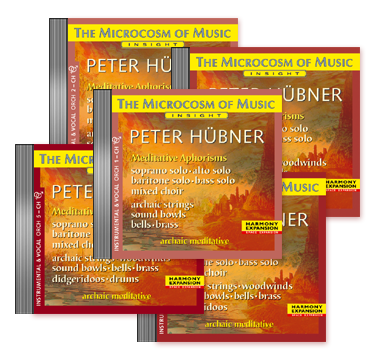| |
|
CLASSIC-Life: there is a group of 20 pieces of work, the so called “Meditative Aphorisms”,
which are to give a special insight into the microcosm of music – if
I am right. You also name different spheres.
These pieces of work mainly give an insight into the tonal family relationships
within the microcosm of music. We can learn a lot from this.
What we know in our human everyday life, the different generations –
great-grandparents, grandparents, parents, children, grandchildren etc.
of both sides – can also be found in the microcosm of music.
Only that in the microcosm of music, there is always one generation that has
the final say, and the other generations – the further they are away
from this generation – have less and less to say, and/or appear more
and more faintly. In the example of the tone with its “overtones”,
we see the corresponding: the so-called overtones, more distant from the fundamental
tone, appear more and more faintly.
There are generation problems everywhere in life. The greater the gap is between
the generations, the more these problems become evident – the more difficult
it seems to get on with each other.
Who is right? – is the question always asked. And each generation claims
to be right. The older ones claim that, due to their old age, they have more
experience, and that is why they should be right. And the younger ones reply
that they have more original creativity, and that for this reason they are
equally entitled to be right. We all know these arguments, and our instinct
tells us: well – it must be like that, it has always been like that,
and it will be the same in future.
The microcosm of
music thoroughly enlightens us in this respect: the generation problem comes
about, when the natural harmonious order between the generations is not observed.
At the same time, the microcosm of music does indeed differentiate between
the generations – but it does not say indiscriminately that the “older
ones” must rank higher in the hierarchy than the “younger ones”.
From the viewpoint
of the microcosm of music, the “older ones” may just as well have
the final say towards the “younger ones” as the “younger ones”
towards the “older ones”, only: it is not possible for them to have
the final say at one and the same time.
The microcosm of
music does indeed differentiate between the past and the future, but seen
from the present both are equally significant. Seen from the microcosm of
music, evolution does not fundamentally move only from the “past”
via the “present” to the “future”, but just as well from
the “future” via the “present” to the “past”.
In this respect,
seen from the microcosm of music – the grandfather is not indiscriminately
the older person and the grandchild the younger person, but they are both
only viewpoints of the person who, from his supposed present looks forward
and / or backwards. If he looks back, he thinks he sees the grandfather, and
if he looks forwards, he thinks he sees the grandchild.
But if the observer
now turns around, he again believes to see the grandfather in the back, whom
he previously regarded as the grandchild, and in front of him the grandchild,
whom he previously considered to be the grandfather.
We always think that all developments only move from the past into the future.
The microcosm of music teaches us that this is a biased prejudice, resulting
from the observer’s view and/or point of view. But the reality can also
be vice versa.
What do we gather
from this? Possibly it is entirely true that the grandchild is the grandfather,
and can thus also claim, as so far only the grandfather has been able to,
that he is older and is therefore right.
Apparently though, there is no doubt for anybody in our time in this respect:
the grandfather is older, that is already in his passport, and the grandchild
is younger, and therefore it doesn’t have a passport yet. For most that
is sufficient evidence. But obviously it doesn’t help to facilitate life
between the grandfather and the grandchild, and to solve the generation problem.
There are grandchildren
who listen to their grandparents, and are happy with that, and there are grandparents,
who listen to their grandchildren, and are also happy to do so. For both to
be happy, one has to listen more to the other. The microcosm of music also
teaches us the same thing.
Why do I range so far afield in my explanations?
The natural problems
of the generations run through our daily lives. And the reasons for this lie
hidden in the existence of space and time, and not at all in the competency
of people – that is what the microcosm of music teaches us. But a harmonious
togetherness can be learned, and it concerns the natural intelligent attitude
towards space and time in our thinking.
The key to harmony
between people is thus founded in the consciousness of the individual: in
his ability to handle space and time in a natural way: to observe natural
space-time-orders, to respect them and on no account to ignore them.
This is what the microcosm of music teaches us – and out of this results
the revelation and/or knowledge of the laws of harmony of the microcosm of
music.
In those “Meditative
Aphorisms” with the general title “Insight into the Microcosm of
Music” I have introduced those space-time-shifts, and thus the generation
problems in a systematic order, and have shown them as a natural phenomenon
of creation.
Sphere 1 introduces only the natural space-time-order of a generation, and you simply
hear that here there are no difficulties and/or no disharmony or dissonance.
In sphere 2, we have two neighbouring generations, i.e., for instance, parents
and children, and/or grandparents and parents. Here, too, there are only slight
tonal difficulties.
In sphere 3, three generations are introduced under the roof of an aphorism,
and here, too, the difficulties appear to be of a relatively minor nature.
In sphere 4 we find four generations in the house of an aphorism, in sphere
5 five generations, accordingly in sphere 6, six generations, and in sphere
7 seven generations.
And in sphere 7 with seven generations under the roof of an aphorism we are very
much reminded of the sounds of atonal music of the avant-garde – whilst
sphere 1 reminded us of simple classical music. In accordance, the other spheres
lie in between, partly closer to folk-music, and partly closer to the music
of the so-called new toners.
These aphorisms all clarify further the space-time-conformity to natural laws, which
we find in the microcosm of music. That is the reason why, in these specific
compositions, I have given all generations the same right to vote – as
is the aspiration in a democracy.
But we can see that this kind of equal democracy is not a natural phenomenon,
and does not function harmoniously if it is not joined in the structure of
a natural hierarchical order.
Thus, in these “Meditative Aphorisms” in totally different orchestral
line-ups I wanted to introduce the space-time-shift as such, and to show that
space and time play a major part in natural harmony: that they can develop,
preserve but also destroy natural harmony, and accordingly, the feeling of
natural harmony.
|
|
“My most beautiful
melodies have come to me in dreams. I practically composed this entire concerto
in a semitrance state in which, however, I was always conscious.
The composer while
creating any work of lasting value stands face to face with this Eternal Energy
from which all life flows, and he draws on that infinite power.
The composer must
sit in the silence and wait for the direction from a force that is superior
to the intellect. If he knows how to contact that power, he becomes the projector
of the infinite invisible into visibility, or rather into audibility, in the
composer’s case. In my opinion, the great composer is not so much the
reflection of God, as has been claimed, but rather the expression of God,
on this earth plane.
In proportion as he grasps this profound truth will he reveal to the visible,
audible world the Divinity within him.”
Max Bruch
_____________
“Truth is within us all;
it takes us
From outward things,
Whate’er we may believe
There is an inmost center
In us all,
Where truth abides
in fulness;
But around
Wall upon wall,
The gross flesh
hems us in.”
Robert Browning
_____________
„Beauty
originates
from a
certain harmony
of contradictions.“
Thomas von Aquin
_____________
“Never was a composer more feted in his own day than Mendelssohn, while
Schuhmann was not recognised at his true worth until long after his death;
but today the verdict is that Schumann was the greater and more original creative
genius.
Mendelssohn died
at 38, but he left no less than 121 opus numbers. Of these only a comparatively
small fraction are still played, but Schumann looms up greater all the time.
Why? Because he was more original.
Mendelssohn had
wonderful fertility of invention. His melodies flow with an ease and spontaneity
that suggest Mozart; he was also a superior craftsman but there is far more
depth to Schumann’s thematic invention and harmonic idioms.”
Max Bruch
_____________
“I did instinctively
what Brahms did both instinctively and consciously. I composed as the spirit
moved me, without comprehending clearly that I was working with great cosmic
law. Whereas Brahms realized, just as Beethoven did, that he was being aided
by Omnipotence. It is only a supreme creative genius who can rise to such
heights.
We composers are projectors of the infinite into the finite.“
Edvard Grieg
_____________
“That two things can be united in a harmonious way without the third
is impossible. Because there must be a connection which unites them. This
can help such proportions realize their ultimate potential. When in any three
numbers the middle one is to the smallest as the largest is in ratio to the
middle one and vice versa, and the smallest to the middle one as the middle
to the largest, then the last and first will be the middle, first and last.
They, all out of necessity, become the same and because they are the same,
become an entity.”
Platon
|

